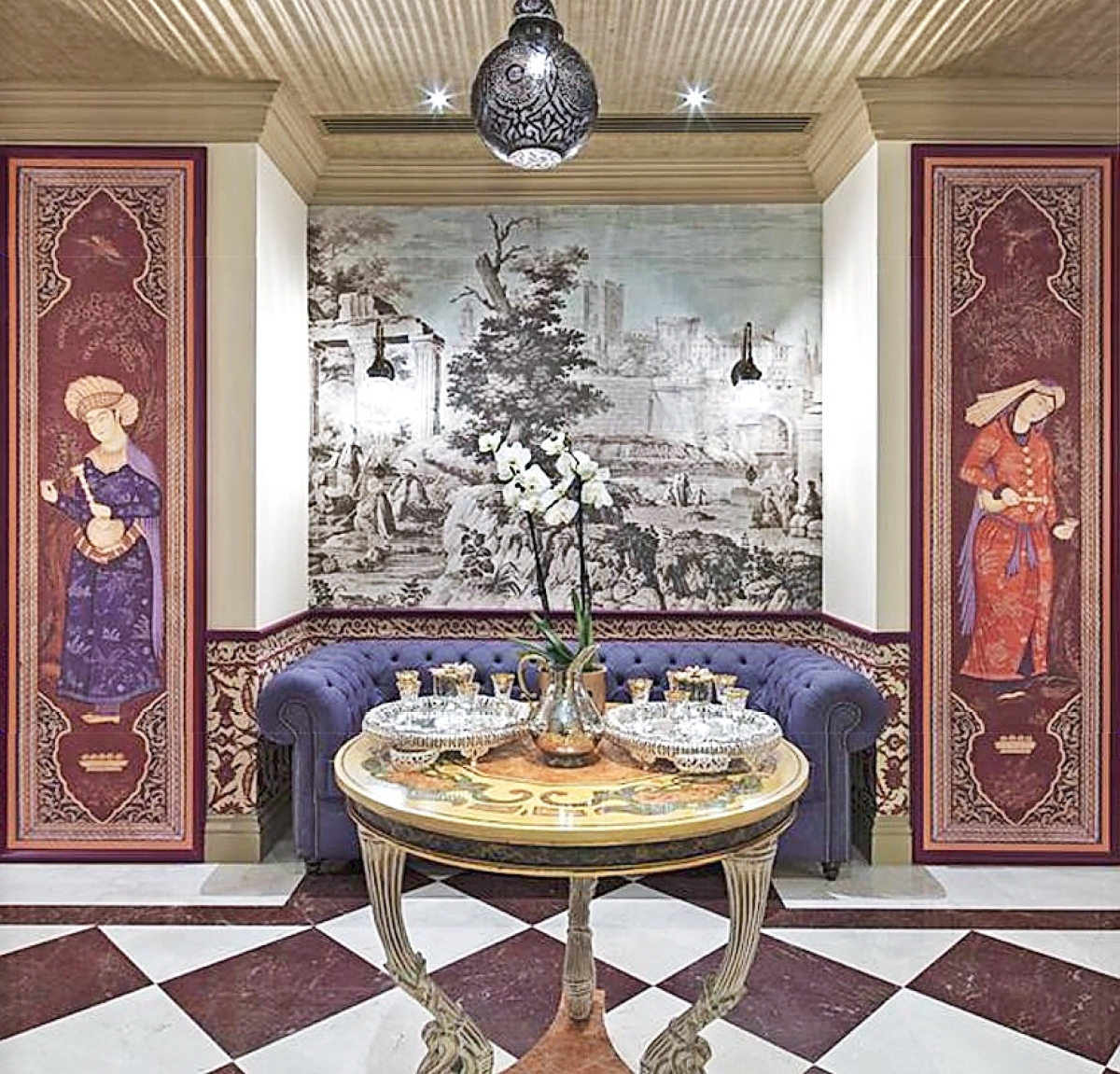
Holly Alderman, artist, photographer and director of Alderman Arts.
“Scenic wallpaper inspires designers and collectors to dream their way, not only into a bygone era, but also into a better one.” Holly Alderman, director of Alderman Arts, quotes Walter Benjamin in describing the world that she creates through her original and recreated historic wallpapers. Alderman designs both repeating and scenic wallpapers, the former presenting repeating patterns of varying intricacy and the latter showing a non-repeating landscape or story, often of faraway or fantastical places. Scenic wallpaper was popular in the early Nineteenth Century with makers such as Joseph Dufour (French, 1754-1827), and Alderman has installed these and her own wallpaper designs in more than 40 cities and six countries for residential, private and commercial spaces. Her commissioned work was featured on This Old House and her exhibition history includes London’s Chelsea Flower Show, the Bellevue House Gardens in Newport, R.I., and many more. Antiques and The Arts Weekly corresponded with Alderman via email to learn about her inspiration and passion for keeping this art form thriving through the Twenty-First Century.
When did you first become interested in antique wallpaper?
My fascination with antique wallpaper began when I was a tour guide at the historic Hooper-Lee-Nichols House in Cambridge, Mass., walking through the rooms to rediscover and explore the monochrome classical scenes again and again. As the designer of a new brochure for visitors to the house, I was strongly advised by a friend, “Be sure to photograph the wallpaper. It’s very famous, by Dufour from Paris. People come from all over the country to see it.”
Later, approaching “The Night Watch” in Amsterdam opened my heart to another world. Art being art rather than a profession, my quest in painting, printing and photography is more often a journey to reveal the unseen, than circle or predictable pattern. Epic storyteller murals and scenic wallpapers seem to me visions of a universal spirit, similar to the ancient agora, permanent public places outdoors and indoors as crossroads for celebration over centuries to rediscover and reinvent perspectives of humanity and our perceptions over layers of time seen and unseen.
Joan Didion said, “Don’t you think sometime people are formed by the landscapes they grow up in? It formed everything I ever think or do or am.” Truly my studio for panoramic landscapes printing antiques anew and painting flowers and gardens and faux architecture originals evolved from my growing up in the Connecticut Valley at the end of a rural road across open fields, surrounded by tall trees and open spaces with faraway pastures, low mountains and long horizons under cosmic clouds, being free to wander around hills and streams and spring floods, turning over slate looking for dinosaur tracks below the elms, watching colors change hourly over miles of steep mountain forests. Dufour’s travelers walking over hills and lands look to me as familiar as coming home after school, except for the Silk Road camel caravans and myriad tents, soldiers, horses and cannons.

“Views of Italy and the Bay of Naples,” designed in 1822 and to be installed in Charleston, S.C., in 2023 (above), and “Views of Antiquity/Turkish Scenes,” 1815, installed in Dublin, N.H., in 2022, both designed by Joseph Dufour and recreated by Holly Alderman.
Please tell us about how your career and studio came to be.
My path glimmered bright while walking by Paolo Uccello’s “Battle of San Romano” at the National Gallery, London, as an unusually bold, saturated wide print compounded and celebrated like a kaleidoscope of bright torn paper abstract collages that captured and expressed the motion and energy of the enormous painting. I shared an undergraduate art studio with a friend and made life-sized models of the white horse in “San Romano.” The next year our shared studio was on Memorial Drive by the Charles River.
My scenic art career jumpstarted again with watercolor sketches of an imaginary Palladian postmodern garden folly as a faux facade mural for the public swimming pool pavilion in Belmont, Mass. The Recreation Department approved my neoclassical architectural rendering, and the Committee to Beautify Belmont and local bank funded 40 quarts of exterior latex. My outdoor studio became 60 feet wide at the front of the cinder block building next to the library on a busy street, and my studio became front page news in the weekly paper.
Midway among the studios of my life, a friend sent me an ad and a note, “Apply to this.” That summer, my studio became a long table among many at the library at the National Academy Museum Mural Fellowship in New York on Museum Mile. I met the frontier of public art in all styles and several venerable souls, including learning digital imaging and photoshop in three days with facilitator-artist Grace Graupe-Pillard.
After the academy, I worked on exhibitions as museum quality fine art digital productions, not reproductions. Creating digital originals is fundamental to the quest to invent realities and art never before possible to imagine. I advanced light-years working with master printer Daniel Saccardo who printed my National Academy open studio tour at his state-of-the-art studio, Superior Giclee. Then we produced my Saint-Gaudens National Park banners exhibit from May through October, featured at the Chelsea Flower Show and Bellevue House Gardens in Newport, R.I., that was published in Digital Graphics by abcde and in 3QD by Elatia Harris.
My understanding came to be that murals are not merely decorative art on walls, they are permanent installations intended to embody the unique social history and meaning of the location and nature of the surrounding environment, with a scale and palette in harmony with the architectural style, uniquely designed to embody the purpose and uses of the room and its geographic orientation, to signify the interests and character of the owner, in a technique with materials that define the present time, and, in an original style that expresses the heart and vision and spirit of the artist. My conclusion is: art of digital imaging and printing transcends, and perhaps eclipses, the cult of the original.

Alderman’s French-style digital production of Joseph Dufour’s “Views of Italy,” currently installed at the Berkshire Galleries, Great Barrington, Mass.
Do you have a favorite design or type of paper that you prefer to work with?
My favorite style of paper for soft patina effects in new antique wallpaper is a sturdy matte nonwoven roll 60 inches wide, made of fibers pressed together somewhat similar to felt fabric but thinner and stronger for fine decorative digital wallpaper printing with finesse of very fine texture ideal for a woodblock hand-carved domino paper tromp l’oeil domino paper (small squares united on larger canvas with glue before the invention of paper in rolls). The paper is beautifully printed in warm grisaille, as well as light sepia, darker traditional palettes or contemporary tones and hues, in which many experiments exist.
A favorite aspect of antique scenic design may be to customize the expansive sky to reflect its site geography and climate as unique local variables. A hint of sky tone enhances the horizon perspective in “Views of Antiquity.” A Dufour sky in Palm Beach is the palest oceanic teal green, the first of many samples, around a formal dining room on Worth Avenue. Rolls of that sky tone look mystical in an Istanbul lobby not far from the Bosphorus. In Las Vegas, a “Views of Italy” print series was hand-embellished in a desert sky sunset blend of pale mango, peach and gold. In Puerto Rico, a “Views of Italy” accent wall sky has deeper blue variations at the edge of the ceiling yet much lighter blue near the horizon. Each location being personalized and one of a kind gives a place more intriguing aura.
Please walk our readers through how you approach a wallpaper installation.
I approach new installations as an “artist-decorator,” honored to renew rare lost art for new audiences and public locations. Most installations are in residences. Scenes are also ideal for hospitality and drama: gourmet restaurants, boutique bars and hotel lobbies, theatre and movie sets, house museum exhibits, staging retail windows and also public art. First, I find the feature wall and begin there with the owner’s favorite chapter, a distant horizon vista or foreground narrative feature. [Next,] my experiences envisioning new installations spark insights for future collaborations with interior designers, innovative printers, color separation artists and fine art photographers.
Is there a house or paper you want to work with, but have not yet been able to access?
In my mind’s eye to scan and renew is a suspenseful Dufour grisaille panorama of marvelous dynamic horse racing at the track, as down the stretch they come beside grandstands and concourses. Horses seem to gallop faster as one walks around the reception hall in an expansive summer cottage [Martha’s] Vineyard estate. Guests who mingle for salons or garden club or chamber music seem to gather with Dufour spectators to join centuries of conversations. The discerning eye finds abundant printing and curling distress that could be renewed yet preserved in trompe l’oeil digital patina. I also admire and reenvision a surprising ceiling of antique faux painted real stained glass between the dark woodwork in formal pergola style, woven with espalier branches, leaves and lemons above, an exquisite challenge for the future of fine digital imaging, color separations and museum-quality printing.
[Editor’s note: For information and consultations, www.aldermanarts.com.]
—Z.G. Burnett








